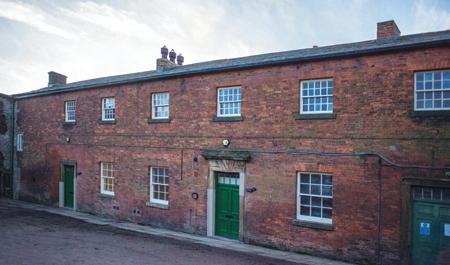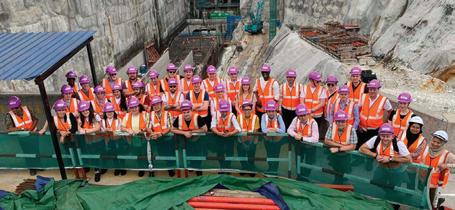
13 minute read
Technical S kanska in Knightsbridge A complex corner site in SW3
Technical
knightsbridge shift
Advertisement
With piles driven ithin millimetres of Tube tunnels and a complex facade retention on London’s most exclusive shopping street, Skanska has its ork cut out on the £150m Knightsbridge Estate scheme. Stephen Cousins reports “On most jobs there are two or three handovers in total, but this construction schedule is very detailed, with nine separate critical paths” John Birch, Skanska
Construction management is all about keeping multiple plates spinning, but with 14 sectional handovers to deliver by 2021 Skanska must focus hearts and minds to deliver the huge Knightsbridge Estate mixed-use development in this well-to-do area of central London.
The contractor is delivering major building works for the scheme, located in the Royal Borough of Kensington
and Chelsea, a mere stone’s throw from Harrods, under a circa £150m lump sum contract with Carraig Investments, a wholly owned subsidiary of the Olayan Group, a private multinational enterprise based in Saudi Arabia.
John Birch, project director at Skanska, told CM: “I’ve been in the industry a long time and on most jobs there are two or three handovers in
Above: The site is at the junction of Brompton Road and Sloane Street
Opposite: Concrete is poured for the building’s frame
Opposite below: The proposed final development
total, but this construction schedule is very detailed, with nine separate critical paths.”
Three retail units will hand over almost a year before Skanska finishes on site and the shops will be trading for six months while the rest of the building is completed.
The logistical imperative to hit p ro g ra m m e m i l e s to n e s m e a n t firstly tackling a number of technical challenges, including the complex substructure and above-ground temporary works designed to streamline and support work on the main build. An ambitious facade retention scheme (FRS) was devised to prevent a patchwork of historic elevations, stretching almost the entire perimeter of the massive 3,800 sq m site, from collapsing onto the street, while the existing building interiors were demolished.
Elaborate foundation works involved the excavation of some 18,000 cu m of muck – 50 lorry loads a day for 10 weeks – to create an 18m-deep, three-storey basement, and the insertion of some 50 piles within a London Underground protection zone.
“At p o i n ts we h a d p i l e s l e ss than 250mm away from London Underground assets, when projects are normally not permitted to go within 3m. That proximity required detailed method statements for the piling work, extra monitoring and London Underground had an engineer on site full time to oversee what we were doing,” says Birch.
Technical story for CM? Email will.m@atompublishing.co.uk
68
The pre-construction agreement ran for 68 weeks
S k a n s k a ’ s i n v o l v e m e n t i n Knightsbridge Estates dates back to July 2016, when it was appointed by Carraig Investments under a 34-week pre-construction services agreement (PCSA) to scope out work based on a design by Fletcher Priest Architects (FPA).
Th e P CSA w a s s u b s e q u e n t l y extended by a further 34 weeks and in early 2018 the main contractor was awarded the build contract. Construction got underway in May. Day-to-day progress on site is overseen by developer Chelsfield, which manages Olayan Group assets in the UK, and a client monitoring team comprising FPA, Waterman Structures and Chapman BDSP.
T h e p r o j e c t i s l o c a t e d o n a roughly rectangular plot of land at the junction of Brompton Road and Sloane Street in the heart of bustling Knightsbridge, where a plethora of upmarket shops and fine dining venues encourage the great and good to part with their cash.
The prime location dictated a retailled scheme (65% by value) with shops spread across basement level 1, ground, first and parts of the second floor. Residential apartments and offices are split across levels 2 to 6 and residents have access to an open-air courtyard garden with an orangery at the centre of the scheme on the second floor. A restaurant is located at the western end of the development on floors 6 and 7.
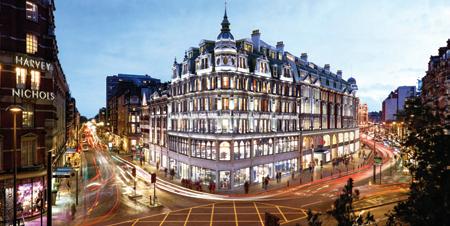
Knightsbridge Estate Value: £150m Programme: 2018-2021 Client: Carraig Developer: Chelsfield Employer’s representative: Aecom Cost consultant: Alinea Main contractor: Skanska Skanska team: Architect: Fletcher Priest Architects Structural engineer: Waterman Structures Building services engineer: Chapman BDSP Key subcontractors: Sub/superstructure: Mitchellsons Steel frame: Severfield Lifts: Kone Cladding and shopfronts: Permasteelisa Facade repair and restoration: PAYE
The superstructure combines a concrete frame for the apartments, needed for acoustic insulation, and a steel frame. The project involves a total 1,000 tonnes of steel and circa 17,300 cu m of concrete (frame and basement).
Knightsbridge Estates integrates w i t h a c c e s s to K n i g h t s b r i d ge Underground station on the Piccadilly Line and, as part of a development
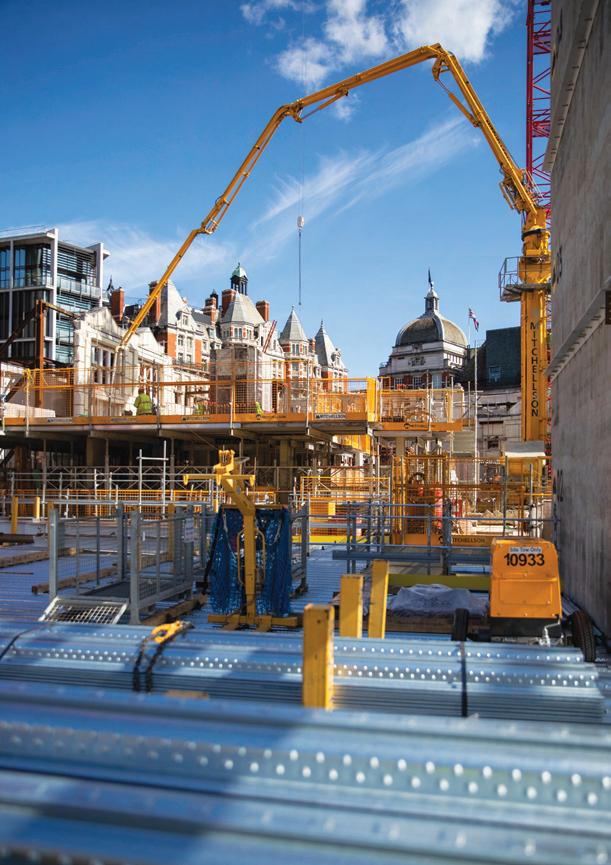
agreement with London Underground, it involves major alterations to station access and circulation.
The main entrance to the tube, on the corner of Sloane Street and Brompton Road, will be converted into a retail unit and replaced by a new entrance in the Brompton Road elevation with a widened pavement for pedestrians. A second entrance will be created
at Hooper’s Court, an alleyway on the western flank of the development, alongside the existing 1906 station entrance with its distinctive ‘oxblood’ glazed red tiling, which will be retained and restored.
A new step-free route to the platforms, including two 17-person lifts at Hooper’s Court, will reopen areas of the station closed in the early 1930s when escalators were introduced.
The site’s proximity to London Underground assets, including two tunnels running under Brompton Road, a disused tunnel that loops away from these at right angles, and two existing cast iron shafts (being converted to accommodate a new lift shaft and fire escape stair) dictated the need for stringent control over ground movement during the formation of the substructure.
Scott Newton, engineering manager at Skanska, says: “Dig a big hole and the ground is going to want to lift up and move inwards, so the temporary works basement propping scheme had to be designed to meet tough trigger limits set by London Underground.” The massive escalator barrel to the north of the site was a particular concern, its horizontal movement had to be kept below 9mm at the top and 17mm at the bottom during excavation. Some 578 structural piles were needed to support the new building, including 1,500mm-diameter piles p o s i t i o n e d away f ro m L o n d o n Underground assets and 50 smaller
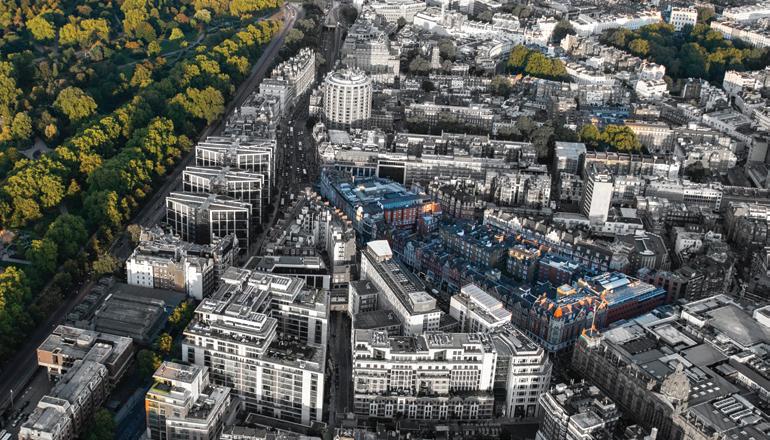

Above: Enabling works behind the retained facade in January 2019
Below: Location of the massive site close to Hyde Park
“If construction projects come within a 3m zone, London Underground has to get involved and a lot of our smaller piles are well within that – four are just over 200mm away” Scott Newton, Skanska
piles of between 600mm and 750mm diameter positioned much closer in. “If construction projects come within a 3m zone, London Underground has to get involved and a lot of our smaller piles, in the area of the disused tunnels and the cast iron shafts, are well within that – four are just over 200mm away,” says Newton.
Detailed method statements for piling in the sub-3m zone were drawn up and reviewed, in discussion with London Underground, the client, its structural engineer and the piling contractor. Work was then carried out in a stop/go process involving regular checks on pile verticality. A small camera was inserted inside the bore holes to check integrity.
Retaining perimeter frontage If pedestrians were unaware of the challenging work going on beneath their feet, they will surely notice the facade retention scheme (FRS), a lattice of chunky steel towers and beams erected around the outside of the existing facade to prevent it from collapsing while the floors behind were demolished.
The decision to retain most of the existing perimeter frontage was unusual, given that just one of the buildings, a 1904-built four-storey property at the corner of Sloane Street and Basil Street, is listed. This is being retained on its existing foundations and refurbished to create apartments.

Hundreds of the best jobs in construction. Recruitment news and insight. Employers seeking CIOB members.

www.constructionmanagerjobs.co.uk

l Expand your knowledge online
l Stay up to date with the latest techniques and technology
l 100s of free CPD articles available
Oxblood red tiling is being retained and restored on the Hooper’s Court facade
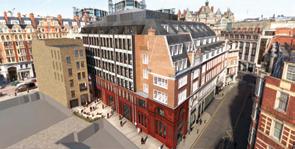
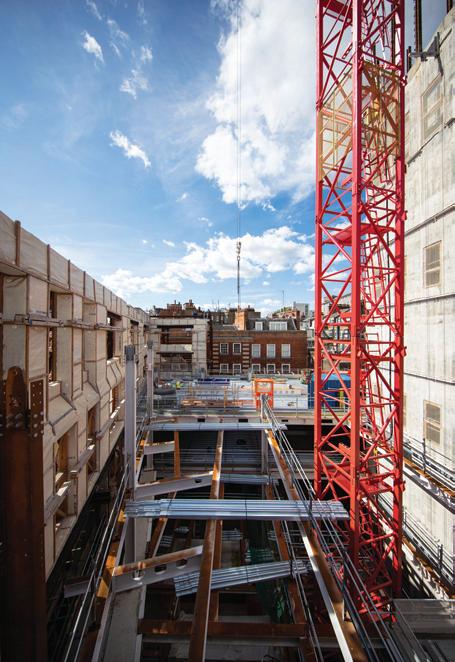
Tom Salmons, senior associate at FPA, told CM: “The project sits within the Hans Town Conservation Area so we wanted to improve the facade, rather than replace it, because it is such an iconic location and the planners didn’t want us to take down the entire city block.”
The reuse of the facade supports the project’s environmental credentials; the offices achieved a BREEAM Excellent rating and the retail Very Good.
Some sections of the frontage were demolished, including a 1950s building at corner of Brompton Road and Hooper’s Court, which did not fit visually with the rest of the scheme. This gap currently provides site access, but will be filled with a recreation of the
Construction work takes place on the steel frame of the new build
building that originally stood on the plot before being bombed in the Second World War. The design was developed in collaboration with the project’s facade repair and restoration specialist PAYE, based on archive photographs and historic reports.
The Hooper’s Court elevation was demolished above ground floor level to make way for a unitised facade with white enamel tiling and a floral pattern inspired by John Hooper, a keen gardener who developed the masterplan for the existing city block. The ornate stone facade of the 1920s building at the corner of Brompton Road and Sloane Street had sections of the first floor removed and reconfigured to create taller windows more suitable for residential use. The original architect’s plan for an impressive corner dome and turret was never fully realised but will be reinstated.
“The facade has undergone a lot of modernising to make it work whilst staying sensitive to the original construction. We’re adapting the existing, but in a way that looks like it is original,” says Salmons.
Facade retention design The FRS was designed by engineering design consultancy Wentworth House Partnership for Keltbray Demolition & Civils as part of the demolition contract. It was subsequently redesigned during Skanska’s PCSA period to meet the needs of main building works, including the requirement to control ground movements during basement excavation.
The steel columns and beams rise to the fourth floor and a height of about 25m and connect back to the facade with timber struts. The bases of the columns plunge through the pavement and are cast into existing vaults underneath, which absorbs loads generated by the movement
of the facade. The vaults around the perimeter were all infilled with concrete and tied together with cast-in reinforcement to create a ‘ring beam’ that anchors the FRS and shores up support for the basement excavation. “The biggest issue with installing an external retention scheme is the need to avoid services in the footpath and we were limited to a certain extent by where services are located,” says Newton. “It meant a lot more preliminary investigations and hand digging to avoid damage.”
The presence of London Underground assets close to the surface, including a ticket hall and escalator barrel at the junction of Brompton Road and Sloane Street, meant the FRS at this location could not connect to the vaults and instead was retained on strip foundations at pavement level. Additional support was provided by a support tower positioned behind the facade.
The project team’s diligent planning and execution for substructure works ultimately paid off and trigger levels for London Underground were never exceeded.
The FRS is now being dismantled as the building’s concrete and steel superstructure rises behind the temporary works structure. Construction work on the Knightsbridge Estate development will continue through 2020 with a scheduled completion date of April 2021. ●

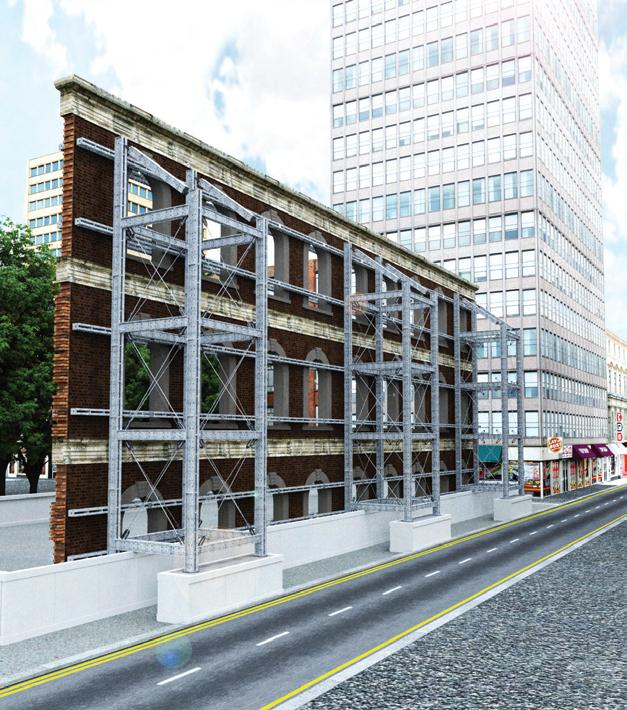
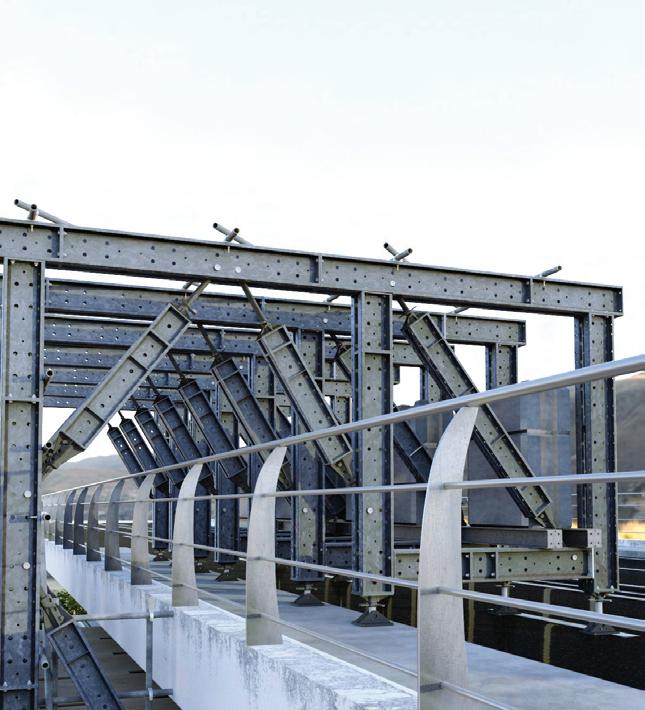
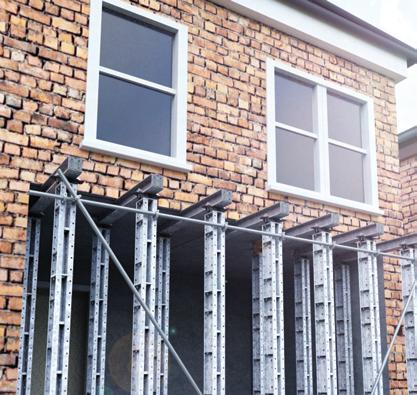
The structural support capability sits alongside our established excavation safety solutions and our growing range of safety products and piling attachments. Each addition to the range broadens our service offering, bringing MGF customer service excellence to new areas of the market for new and existing customers.
This addition will provide structural propping, jacking and support solutions across the Building and Civil Engineering industries and is built on MGF values: ensuring our customers receive quality, specialist temporary works solutions. Driven by our commitment to improvement, all MGF structural support products have been designed by our development team in consultation with customers and market specialists to deliver innovative products and premium quality whilst meeting the changing demands of today’s construction industry.
With safety and simplicity in mind, the UniShore system has been designed and manufactured in-house to Eurocodes and BS EN 1090 Execution class 3 with the high-grade Strenx® steel and unique section profile minimising component weight whilst giving market leading performance. The system is built from three capacities in light, medium and heavy sections all of which are fully interconnectable offering vertical load capacities of 20, 70 and 150 tonnes to provide designers and site teams with safe, economic solutions to structural support requirements. A full range of bracing and accessories are also available for each of the three capacities including hydraulic jacking capability for the medium and heavy sections to facilitate the controlled application and release of loads and structure movement applications. Bracing accessories feature pinned connections wherever possible, simplifying and speeding installation and removal minimising risk and cost.
MGF’s Structural Support Solutions division is based at our new North West – Warrington premises and will service the whole of the UK throughout our expanding depot network. We are delighted that Chris Carter has joined MGF to lead the Structural Support Solutions business into the industry as Managing Director, bringing with him a wealth of knowledge from his 35 years’ experience within structural support. “Having listened to the industry we have used modern high-grade steels and production techniques to design a system that offers real benefits to our customers. Backed by MGF’s excellent engineering and operations teams we are looking forward to delivering industry leading structural support solutions and service to customers”
Detailed technical information is provided in the UniShore technical file. User information and RAMS guidance are available at mgf.ltd.uk.


